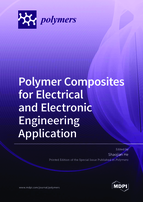Polymer Composites for Electrical and Electronic Engineering Application
A special issue of Polymers (ISSN 2073-4360). This special issue belongs to the section "Polymer Applications".
Deadline for manuscript submissions: closed (28 February 2022) | Viewed by 27949
Special Issue Editor
Interests: polymer insulation materials; high-performance rubber nanocomposites; energy materials
Special Issues, Collections and Topics in MDPI journals
Special Issue Information
Dear Colleagues,
We cordially invite you to submit your research papers, communications or review articles to the Special Issue entitled “Polymer Composites for Electrical and Electronic Engineering Application”.
Polymer composite materials have attracted great interest for the development of electrical and electronic engineering and technology, and have been widely applied in electrical power systems, electrical insulation equipment, electrical and electronic devices, etc. Due to the significant expansion in the use of newly developed polymer composite materials, it is necessary to understand and accurately describe the relationship between composite structure and material properties, as only based on thorough laboratory characterization is it possible to estimate the properties for their future commercial applications.
This Special Issue focuses on polymer composites applied in the field of electrical and electronic equipment, including but not limited to synthesis and preparation of new polymeric materials, structure–properties relationship of polymer composites, evaluation of materials application, simulation and modelling of material performance.
We are looking forward to receiving your outstanding work for this Special Issue.
Dr. Shaojian He
Guest Editor
Manuscript Submission Information
Manuscripts should be submitted online at www.mdpi.com by registering and logging in to this website. Once you are registered, click here to go to the submission form. Manuscripts can be submitted until the deadline. All submissions that pass pre-check are peer-reviewed. Accepted papers will be published continuously in the journal (as soon as accepted) and will be listed together on the special issue website. Research articles, review articles as well as short communications are invited. For planned papers, a title and short abstract (about 100 words) can be sent to the Editorial Office for announcement on this website.
Submitted manuscripts should not have been published previously, nor be under consideration for publication elsewhere (except conference proceedings papers). All manuscripts are thoroughly refereed through a single-blind peer-review process. A guide for authors and other relevant information for submission of manuscripts is available on the Instructions for Authors page. Polymers is an international peer-reviewed open access semimonthly journal published by MDPI.
Please visit the Instructions for Authors page before submitting a manuscript. The Article Processing Charge (APC) for publication in this open access journal is 2700 CHF (Swiss Francs). Submitted papers should be well formatted and use good English. Authors may use MDPI's English editing service prior to publication or during author revisions.
Keywords
- polymer composite
- electrical insulation
- electronic materials
- electromagnetic shielding
- dielectric properties
- mechanical properties
- heat dissipation
- breakdown
- aging







